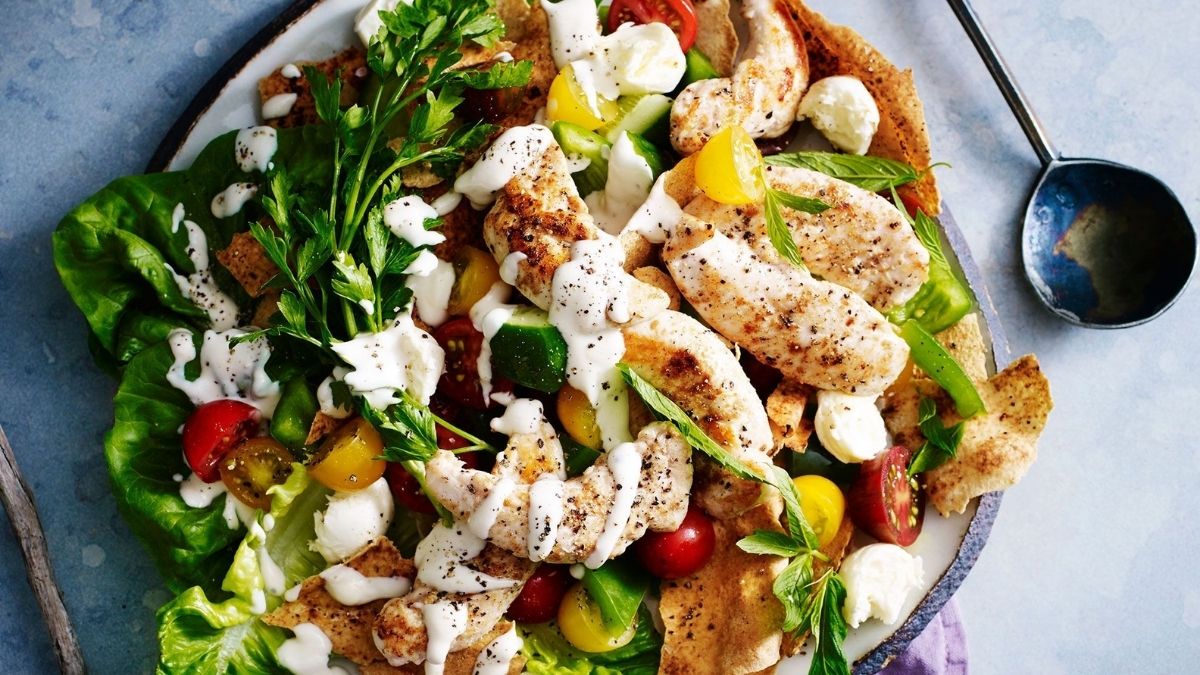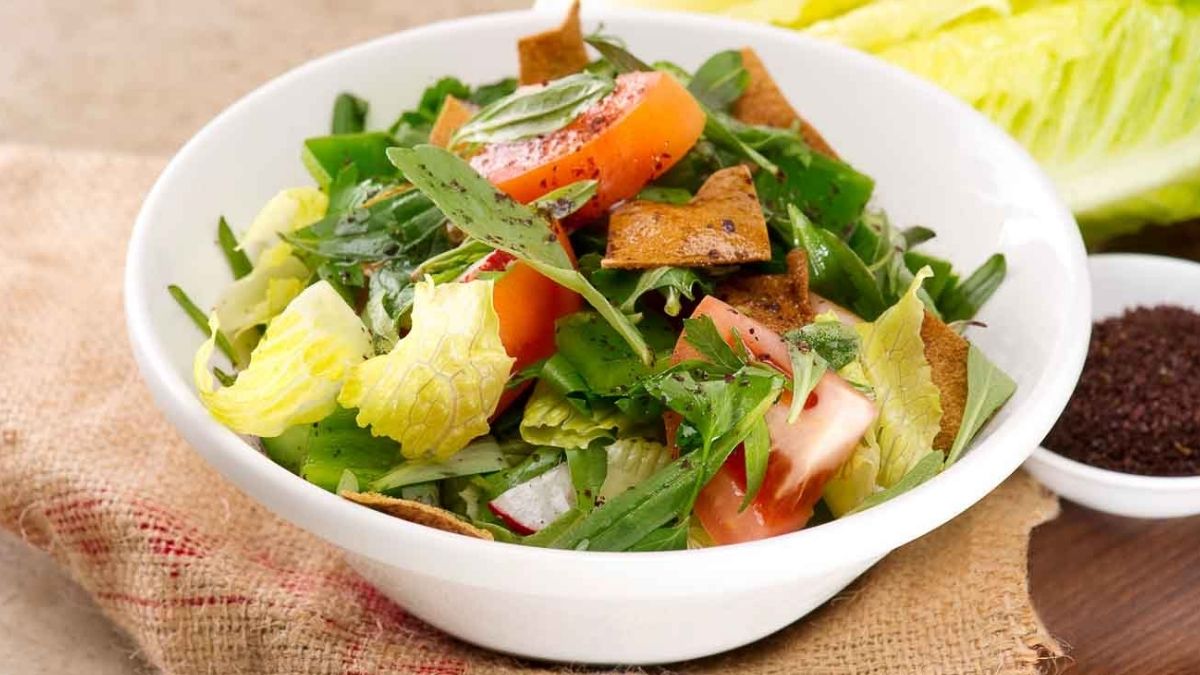A fattoush salad is a fabulous Middle Eastern salad featuring cucumbers, tomatoes, lettuce, onions, seasoned fried pita croutons, and a dressing made of oil and spices, including parsley sumac and garlic. Like peppers and radishes, other vegetables may be used in some fattoush salads. Weight loss reduces insulin secretion – more excellent sports performance. Lower risk of diabetes, heart disease, hypertension, and most malignancies benefits from eating a diet rich in vegetables and whole foods like the Fattoush salad.
Fattoush salad is more of a Suriah dish than a Lebanon salad. People throughout the country are becoming more familiar with this type of salad as time passes. Furthermore, several restaurants in Lebanon have added this appetizer to their menu. This meal is one of the diet’s recommended foods because of its unique flavor and health benefits.
What is Fattoush?
Fattoush is a Middle Eastern salad made with torn pita bread, croutons, and fresh veggies (typically tomato and cucumber) (known as fatteh in Arabic). Although tomato and cucumber are common ingredients, fattoush frequently incorporates radishes, romaine lettuce, onions, purslane, and bell peppers. Fattoush is a mix of Lebanese tabbouleh and Italian Panzanella, with plenty of fresh herbs and bread to soak up a bright, lemony sauce.
How to Make Fattoush?
The Fattoush Salad is a popular dish on the Middle Eastern dinner table. A tangy lime vinaigrette dresses a simple chopped salad. Croutons prepared from homemade pita chips! Below is a video and step-by-step guide on how to make fattoush.
Tips for Making Fattoush
As with any fresh salad, fattoush is the sum of its parts. So here are just a few tips:
- Begin by picking the best produce you can find, such as ripe tomatoes and freshly picked herbs.
- Use store-bought pita chips instead (there is certainly a place for those, but not in fattoush salad). To toast and fry your pita at home, season them thoroughly.
- Please avoid skipping sumac. It’s a unique spice made from pulverized sumac berries with a sour flavor that’s difficult to duplicate.
- Make sure to use the best extra virgin olive oil you can find. Its spicy, fruity flavor is crucial in this dish. Remember that olive oils branded “pure” have been heat-treated and processed mechanically, lacking character and flavor.
- Finally, remember that this is a “basic” fattoush recipe. Try adding in-season vegetables like colorful heirloom tomatoes or even green peppers to make your variety. More herbs or smashed garlic can be added. If you have access to it, add one teaspoon of pomegranate molasses to the vinaigrette.
Ingredients
- Two loaves of pita bread
- Extra virgin olive oil
- Kosher salt
- 2 tsp sumac, divided, more as needed
- One heart of Romaine lettuce, chopped
- 1 English cucumber, cut in half, seeds scraped, then chopped or sliced into half-moons
- 5 Roma tomatoes, chopped
- Five green onions (both white and green parts), chopped
- Five radishes stem removed, thinly sliced
- 2 cups chopped fresh parsley leaves, stems removed
- 1 cup chopped fresh mint leaves (optional)
Instructions
- Pita bread should be broken into little bite-size pieces. IHeatthree tablespoons of olive oil in a large skillet until shimmering, then add the pita bread. Fry until golden brown, tossing often. Transfer the fried pita chips to a plate lined with paper towels to drain using tongs. Season with sumac, salt, and pepper.
- In a large mixing basin, combine the chopped lettuce, cucumber, tomatoes, green onions, sliced radish, and parsley.
- To create the dressing, combine the lemon or lime juice, olive oil, pomegranate molasses (if using), salt, pepper, and spices in a small mixing bowl.
Pour and lightly toss. Finally, toss in the pita chips and additional sumac if desired. Place in tiny serving bowls or platters to serve.
Fattoush Recipe
What to Serve with Fattoush?
Fattoush is an excellent accompaniment to practically any Middle Eastern or Mediterranean main dish. For a light lunch, add protein in the shape of cheese or chickpeas. Serve fattoush with falafel, lamb kebabs, za’atar seasoned chicken, or grilled Mediterranean shrimp. You can also serve it with hummus, baba ganoush, and other small pieces as part of a mezze (appetizer platter).
Fattoush is an excellent accompaniment to practically any Middle Eastern or Mediterranean main dish. For a light lunch, add protein in the shape of cheese or chickpeas. Serve fattoush with falafel, lamb kebabs, za’atar seasoned chicken, or grilled Mediterranean shrimp.
Is Fattoush Salad Keto-Friendly?
With a few tweaks, a fattoush salad may be made keto-friendly. You might, for example, replace the pita chips with Edam crisps to avoid missing out on the crunchy texture of the pita chips. For added crunch, add some store-bought keto crackers to your salad.
Using a store-bought dressing, make your keto-friendly dressing using olive oil, lemon juice, parsley, sumac, and garlic powder to get that real fattoush salad taste without the possible high-carb ingredients. If you’re eating out, try to ring the bell or inquire about the dressing they’re using; most chefs are unexpectedly keen to discuss their craft.
What are the Health Benefits of Fattoush Salad?
1. Healthy Digestive
Salads typically include a significant amount of fiber. As a result, this salad will aid in the management of a better digestive system, resulting in improved intestinal bowel movement. As a result, the digest rate might increase, avoiding a secondary issue such as constipation. This is similar to the health advantages of Otaheite apple seeds in terms of maintaining a healthy digestive system.
2. Weight Management
When the digestive system is better, it will also assist with weight management. As a result, it is no longer a mystery that salad is the ideal menu for individuals looking to lose weight. It will help boost weight loss faster when combined with a good habit and exercise. This is why this dish is popular healthy diet food.
3. Improve Metabolism
Other advantages of the fattoush salad include improved body metabolism. It can aid in increasing the body’s metabolic rate, which converts food into energy for daily activities. This is one of the health benefits of mesclun salad, which also helps to boost body metabolism.
4. Avoid Fat
When the digestive and metabolic systems are in good shape, the body can absorb nutrients more efficiently. As a result, it’s another technique to keep Fat from developing in your body. Making muscle lean and maintaining a healthy body.
5. Body Shaping
This helps produce a better body form, but it also helps the technique of avoiding Fat. When Fat is removed and replaced with muscular mass, an excellent body shape improves one’s attractiveness.
7. Younger Appearance
The dish’s antioxidant content will aid in maintaining a youthful face and body. Because it can improve your body’s looks and make you look younger.
8. Smooth And Silky Skin
The vitamin E level of fattoush salad is also high. This is the nutrient that will improve the appearance of your skin. It provides a smooth and silky complexion that is radiant and attractive. As a result, it’s no surprise that salad eaters have softer skin.
9. Healthy Skin
It helps to generate attractive skin, but it also looks after the skin’s health. It aids in the prevention of additional complications and skin inflammation. For example, getting rid of acne and avoiding eczema. The benefits of soapberry for skin health are also beneficial in providing a healthier skin state.
10. Manage Cardiovascular
Salad consumption is also beneficial to the circulatory system. It can maintain a healthy blood cardiovascular system and prevent additional blood clots. As a result, any difficulties related to cardiovascular disorders such as heart attack or stroke would be avoided.
Conclusion
Fattoush is an excellent accompaniment to practically any Middle Eastern or Mediterranean main dish. For a light lunch, add protein in the shape of cheese or chickpeas. Serve fattoush with falafel, lamb kebabs, za’atar seasoned chicken, or grilled Mediterranean shrimp. Fattoush is supposed to have originated in Northern Lebanon when farmers had dried or leftover pita bread, which explains why there are so many different ways to make it.
They would combine it with other vegetables in a salad and season it with olive oil for added flavor. Fattoush is derived from “fatta,” which refers to Middle Eastern dishes made with stale or day-old flatbread. Fattoush’s toasted pita bread is a delightful alternative to regular croutons, and this salad is a great way to use up leftover handmade pita bread. Fattoush has a bright, forceful, and refreshing flavor, with herbal and vegetal overtones heightened by the sumac and vinegar’s acidity. It can be eaten on its own, with grilled foods like chicken or steak added to bulk it out or as a side dish or appetizer.

